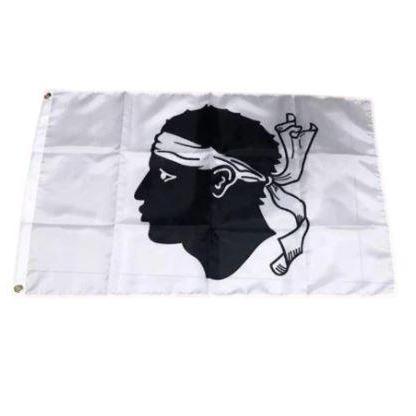Testa Di Moru (Moor's Head): Hidden Meaning of the Corsican Flag
The flag of Corsica is one of the most identifiable and most appreciated in Europe.
Against an immaculate white background, a black face shown in profile is there, its silhouette drawing a striking contrast.
But actually, who does this head belong to?
And what is the history of the Corsican flag?
We are going together today to try to learn more about this standard which is the pride of an entire people.
Contents :

But whose head is the Corsican flag?
As you can see on this flag from our collection, the head of the Corsican flag actually represents a “ Moor’s head ”.
The Moors, sometimes also called Saracens, were pirates from the Maghreb who ravaged the Mediterranean coasts throughout the Middle Ages.
Bandits, criminals and marauders: all wanted the treasures of the Isle of Beauty, and raids were common.
In all, thousands of Corsicans (and more broadly Europeans) were reduced to slavery.
The Corsican fighters were valiant but, for centuries, the Berbers and other invaders from North Africa caused terror.
It was precisely to mark the victory over the Moorish pirates that the “Moor’s head” flag was created.
Since only the head was there, such a standard represented a decapitation, and frightened approaching pirates and barbarians.
Some banners were used to show the power of a nation. Such a coat of arms expressed that of a king.
The blue-white-red flag expresses the ideals of the Revolution. The banner of the French monarchy shows fleurs-de-lys, and therefore Christianity. The ancient Breton flag represents the history of the Celts.
The Corsican flag shows that the island has always remained Christian, never giving in to attacks from Africa and the Middle East.
Other possible meanings
Even if the theory which has just been stated is the most plausible, there are two others just as interesting about these coats of arms.
The first is that the head of the Corsican flag represents an emir defeated by the king of Aragon in the 11th century, thus liberating part of the Mediterranean.
The color black would then have been chosen as a symbol of evil, and therefore of the triumph of the Aragonese over the barbarians.
Interestingly, Sardinia (the island just south of Corsica) also has a flag marked with Moorish heads. And for the Sardinians, it is this theory that prevails.
The third version of the story instead tells us that the flag of Corsica is a reference to Saint Maurice, the black patron saint of the Holy Roman Empire.
A bit like the figure of the Black Madonna, Saint Maurice is a European character but one whom the Catholic tradition has portrayed under dark features.
If Saint Maurice was able to protect Corsica, undoubtedly it was historically through the patronage of the Republic of Genoa, which governed the Isle of Beauty during a good part of the Renaissance.
The Genoese influence is still felt today, particularly in Corsica's link to the Sardinian nation.
More broadly, if you are interested in the rich and great culture of the Corsican people, here is a collection of symbols and lucky charms straight from the Isle of Beauty which should interest you!

In Bandera Corsica: history of the Corsican flag
On a white background, with a black head wearing a white headband: the one that the Corsicans call “ A Testa di Moru ” is recognizable among all the flags.
But in fact, what is the history of this independence emblem?
As said previously, it appears that the flag was first used to scare away Moorish pirates, possibly under Aragonese influence.
However, it was the Virgin Mary who was used as the official symbol of the island from the end of the 13th century…
It was indeed necessary to wait for the revolutionary independence movements for “A Bandera Corsica” to return to the forefront.
In 1736, a German adventurer named Théodore Van Neuhoff managed to push the Corsicans to revolt and founded a short-lived kingdom. He chose the Moor's head as the island's flag.
His dream did not last long, and his power was quickly removed. The hopes of the Corsicans, however, did not weaken and, in 1762, a new revolution was led by Pasquale Paoli, sometimes also called Pascal Paoli... a Corsican this time!
Thus, during the establishment of the independent republic, “A Testa di Moru” was once again chosen to take pride of place on the Corsican flag.
Interesting fact: the original design showed the blindfold on the Moor's head. To mark the liberation of his people, Pasquale Paoli decided that it would instead be placed on his front.
Since then, the flags and coats of arms of the country show a white band symbol of a nationalist and proud party.
Later, with the arrival of Napoleon, the French tricolor replaced the Corsican flag but, never in the hearts of the islanders “A Bandera Corsica” could be dethroned.
Official emblem of Corsican nationalists, this scarf formerly worn over the eyes today shows the revolt, the true legends and the refusal of domination specific to the Corsican people.
Lucky charm featured in this article

Flag with Moorish Head (a Bandera Corsica)
See more

